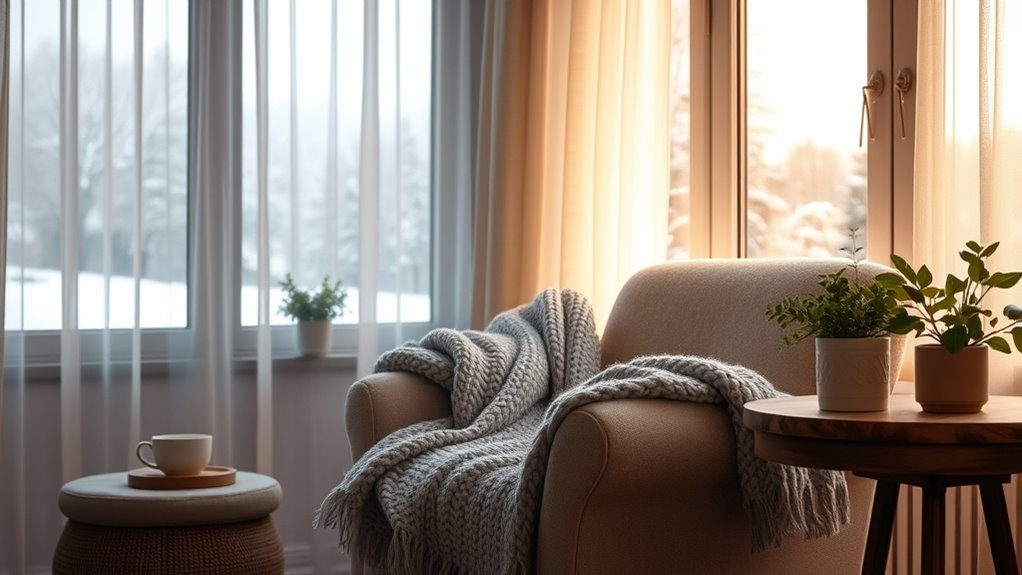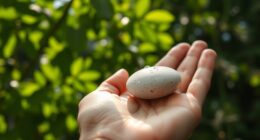To combat winter blues (SAD), try evidence-based strategies like light therapy and vitamin D supplements. Using a light box that mimics sunlight for 20-30 minutes each morning can boost your mood and energy levels. Alongside, increasing your vitamin D intake through supplements or diet supports mood regulation and immune health. These approaches work best when combined consistently, and exploring more can help you find the right plan to lift your spirits all season long.
Key Takeaways
- Light therapy using a 10,000 lux light box effectively alleviates SAD symptoms when used daily in the morning.
- Increasing outdoor sunlight exposure and taking vitamin D supplements can help improve mood during winter months.
- Maintaining a regular sleep schedule and engaging in physical activity support circadian rhythm regulation and reduce winter blues.
- Consuming vitamin D-rich foods and ensuring adequate intake may mitigate vitamin D deficiency linked to SAD.
- Combining light therapy with vitamin D supplementation and lifestyle adjustments offers a comprehensive, evidence-based approach to managing SAD.

As winter days grow shorter and darker, many people experience feelings of low energy, sadness, or irritability—commonly known as Seasonal Affective Disorder (SAD). This shift in mood often results from reduced sunlight exposure, which influences your body’s internal clock and chemical balances. One key factor linked to SAD is a decrease in vitamin D levels. Sunlight prompts your skin to produce vitamin D, a nutrient essential for mood regulation and immune function. When sunlight diminishes, your vitamin D production drops, possibly contributing to feelings of depression and fatigue. To counteract this, you might consider taking vitamin D supplements or eating foods rich in this nutrient, such as fatty fish, fortified dairy, and eggs. However, supplements should be used under medical guidance to ensure appropriate dosing.
Another highly effective strategy is light therapy, which involves sitting near a specialized light box that mimics natural sunlight. This treatment helps compensate for the reduced sunlight during winter months. By exposing yourself to bright light for about 20 to 30 minutes each morning, you can influence your circadian rhythms, improving sleep patterns and boosting your mood. Light therapy is especially beneficial because it’s non-invasive and can be integrated easily into your daily routine. To maximize its benefits, ensure the light box filters out UV rays and provides at least 10,000 lux of illumination. Consistency is key, so make it a daily habit, preferably at the same time each morning.
Combining these approaches can help you manage winter blues more effectively. Using light therapy alongside vitamin D supplementation can create a synergistic effect, addressing both the environmental and physiological causes of SAD. Remember to monitor your symptoms and consult with a healthcare professional if you notice persistent or worsening symptoms. They can help you determine the right dosages and treatment plan tailored to your needs. While these strategies are backed by research, it’s important to recognize that individual responses may vary. Some people find relief quickly, while others may need a combination of treatments, including therapy or medication, to feel better. The bottom line is that proactive steps like increasing vitamin D intake and embracing light therapy offer promising, evidence-based options to combat the winter blues and restore your mood and energy during the darker months.
Frequently Asked Questions
Can Diet Changes Help Alleviate Seasonal Affective Disorder Symptoms?
Yes, diet changes can help alleviate SAD symptoms. You should focus on nutrition planning by including foods rich in omega-3 fatty acids, vitamin D, and complex carbs, which support mood regulation. Additionally, incorporating dietary supplements like vitamin D can be beneficial if you’re lacking sunlight. These strategies may improve your overall well-being, providing more energy and reducing depressive feelings during the darker months.
Are There Specific Exercises Proven to Combat Winter Depression Effectively?
You can effectively combat winter depression with specific exercises like indoor cardio and strength training. Indoor cardio, such as brisk walking or cycling on a stationary bike, boosts your mood by increasing endorphin levels. Strength training helps reduce symptoms by improving sleep and energy. Regularly engaging in these exercises, especially during winter months, can lift your spirits and combat feelings of depression associated with seasonal changes.
How Does Sleep Quality Influence Winter Blues Severity?
Think of sleep quality like a well-tuned orchestra—when it’s off, everything suffers. Poor sleep hygiene can disrupt your circadian rhythms, making winter blues feel worse. When you sleep poorly, your mood dips, and energy wanes. Prioritize consistent bedtimes, limit screens before sleep, and create a calming environment. Good sleep helps stabilize your circadian rhythms, reducing the severity of winter blues and boosting your overall mood.
Can Social Activities Reduce Feelings of Seasonal Sadness?
Yes, engaging in social activities can help reduce feelings of seasonal sadness. When you participate in social interaction and community engagement, your brain releases feel-good chemicals like endorphins, which boost your mood. Connecting with others offers support, distraction, and a sense of belonging, all of which combat loneliness and sadness during winter months. So, make an effort to stay socially active; it’s a simple, effective way to lift your spirits.
Are Natural Supplements a Safe Alternative to Light Therapy?
Natural supplements like herbal supplements can seem like a safe alternative to light therapy, but you should always consider supplement safety first. Many herbal supplements are generally safe when used as directed, but they can interact with medications or cause side effects. Before trying herbal remedies for seasonal sadness, consult your healthcare provider to guarantee they’re appropriate for you. Never replace evidence-based treatments without professional guidance.
Conclusion
Remember, battling the winter blues is like fixing a broken mirror—you’ll need patience and the right tools. By embracing light therapy, staying active, and maintaining routines, you can outsmart the gloom. Think of it as tuning your old radio to catch those joyful broadcasts again. Don’t let the season’s chill turn your mood into a forgotten relic. With these strategies, you’ll keep your spirits bright, even when the snow is falling like a scene from a vintage postcard.








